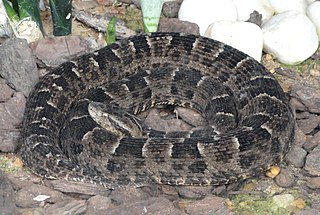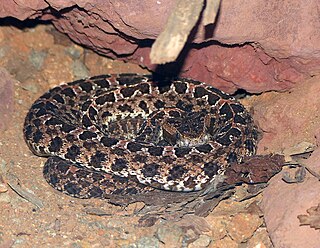
Metlapilcoatlus is a genus of venomous pit vipers endemic to Mexico and Central America. Five species are currently recognized. The common names suggest they are able to leap at an attacker, but this is likely exaggerated. Common names for the species include jumping pitvipers and jumping vipers.

Bothrops atrox — also known as the common lancehead, fer-de-lance, barba amarilla and mapepire balsain — is a highly venomous pit viper species found in the tropical lowlands of northern South America east of the Andes. No subspecies are currently recognized.

Bothrops alternatus is a venomous pit viper species found in South America. Within its range, it is an important cause of snakebite. The specific name, alternatus, which is Latin for "alternating", is apparently a reference to the staggered markings along the body. No subspecies are currently recognized.

Porthidium is a genus of venomous pitvipers found in Mexico and southward to northern South America. The name is derived from the Greek word portheo and the suffix -idus, which mean "destroy" and "having the nature of", apparently a reference to the venom. As of August 2016 nine species are recognized as being valid. The snakes of the genus Hypnale in southern India and Sri Lanka look quite similar to those of this genus, possibly an example of convergent evolution.

Bothrops ammodytoides is a venomous pit viper species endemic to Argentina. No subspecies are currently recognized.

Bothrops jararaca — known as the jararaca or yarara — is a species of a highly venomous pit viper endemic to South America in southern Brazil, Paraguay, and northern Argentina. The specific name, jararaca, is derived from the Tupi words yarará and ca, which mean "large snake". Within its geographic range, it is often abundant and is an important cause of snakebite. No subspecies are currently recognized.

Bothriechis aurifer is a venomous pit viper species found in Mexico and Guatemala. No subspecies are currently recognized.

Bothrops taeniatus, the speckled forest-pitviper, is a species of pit viper found in the equatorial forests of South America endemic to Colombia, Ecuador, Peru, And Brazil. The specific name, taenia, is derived from the Greek word, tainia, meaning ribbon bandage or stripe, in reference to the slender body. Two subspecies are currently recognized, including the nominate subspecies described here.

Bothrops neuwiedi is a highly venomous pit viper species endemic to South America. This relatively small snake has a wide range and is a major source of snakebite in Argentina. It was named after German naturalist Prince Maximilian of Wied-Neuwied (1782-1867), who made important collections in Brazil (1815-1817). Seven subspecies are currently recognized, including the nominate subspecies described here.

Bothrops bilineatus, also known as the two-striped forest-pitviper, parrotsnake, Amazonian palm viper, or green jararaca, is a highly venomous species of pit viper found in the Amazon region of South America. Two subspecies are currently recognized, including the nominate subspecies described here. A pale green arboreal species that may reach 1 m (3.3 ft) in length, it is an important cause of snakebite throughout the entire Amazon region.

Porthidium ophryomegas is a venomous pitviper species found in Central America. No subspecies are currently recognized.
Gloydius strauchi is a species of venomous pit viper in the subfamily Crotalinae of the family Viperidae. The species is native to western China. It is a small snake with a pattern of four longitudinal stripes, although some older specimens may be a uniform black. G. strauchi may be distinguished from G. monticola by its higher midbody dorsal scale count. This species jointly holds the altitude record for pitvipers together with Crotalus triseriatus of Mexico, both being found even above the tree line at over 4,000 m (13,000 ft). There are no subspecies that are recognized as being valid.

Gloydius ussuriensis is a venomous pitviper species endemic to far east Russia, northeastern China and the Korean Peninsula. No subspecies are currently recognized.
Bothrops medusa is a venomous pitviper species found in Venezuela. No subspecies are currently recognized.

Bothrops oligolepis is a venomous pitviper species found in Peru and Bolivia. The specific name is derived from the Greek words oligo and lepis, meaning "few scales"; probably an allusion to the lower numbers of dorsal and ventral scales that it has compared to B. bilineatus. No subspecies are currently recognized.
Bothrops punctatus is a venomous pitviper species found in South America and Panama. No subspecies are currently recognized.

Bothrops bilineatus smaragdinus is a venomous pitviper subspecies found in the northern and western Amazon region of South America.
Bothrocophias andianus is a venomous pit viper species endemic to the Andes in South America. No subspecies are currently recognized.

Bothrops brazili is a venomous pitviper species endemic to South America. No subspecies are currently recognized.
Bothrocophias campbelli, commonly known as Campbell's toadheaded viper or the Ecuadorian toadheaded pitviper, is a species of venomous pitviper in the family Viperidae. The species is endemic to South America. No subspecies are currently recognized.














